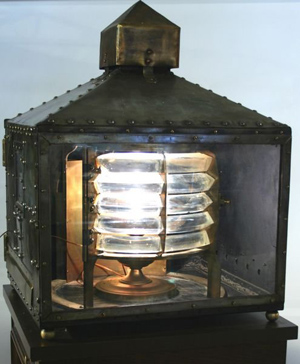
Gronow, in the more than 25 years he’s collected artifacts such as lighthouse lenses and other nautical equipment, has traveled to places such as South America, Germany and Australia.
The museum is set up inside Gronow’s Genoa Township home. The museum is not generally open to the public, he said, but he does occasionally make the display available for viewing through local civic events and fundraisers.
Gronow works with lighthouse historians to grow his collection.
“It’s a small community. We all know each other and appreciate the history of lighthouses and the things that can be found. If one of us finds something someone else may be interested in, we try to make contact with that person,” he said.
That appreciation in 2003 led Gronow to the Middle Eastern country of Bahrain – a country troubled by terrorism and recently the site of protests.
Gronow had heard about a number of items, including rare lighthouse lenses, being sold as scrap metal. He told the seller he’d pay 10 times the scrap value, hopped a flight to the Middle East, and brought back a 40-foot container filled with artifacts.
Had it not been for his grandfather and their fishing trips to Detroit’s Belle Isle years earlier, Gronow may have developed another passion.
“Just sitting on the rocks as a 10-year-old, fishing with my grandfather, got me started with loving nautical things,” Gronow said. “I took my pole and threw it into the water. It didn’t hit the bottom, but I came up with two perch.”
Then came true inspiration.
“A freighter came by. And I couldn’t tell you what the name of it was, but I wanted to know about it, how it was navigated at night. That’s where my enthusiasm for lighthouse history came from,” he said.
The Maritime Exchange Museum on Belle Isle is home to the world’s largest collection of lighthouse lenses, buoy lights and related lighthouse antiques, according to Gronow, whose home has served as the site of LACASA’s annual Deck the Halls fundraiser.
One of the jewels of the museum, he said, is a fourth-order fixed light lens. Lenses of this type, Gronow said, were utilized in lighthouses in Europe and North America.
One lens Gronow has was originally built in 1908 and aided ships in Sydney, Australia, he said. The glass lens, which resembles a beehive, sits in a tower at the end of a tall, winding, wooden staircase inside the museum.
The lens is about 12 feet high and has concentric rings of glass prisms above and below a center drum section to bend the light into a narrow beam.
“These kept the light keepers busy,” Gronow said. “They had to be kept lit every night during the navigation season. If they weren’t lit or there were problems with the lens, that was trouble, because if you were piloting a ship, you couldn’t see where you were going.”
Obtaining the piece was no easy task, Gronow said. He said it sat in a number of basements and bars for about 40 years after being sold at an auction in the 1960s.
Luckily for him, a log of the people who purchased items at that particular auction was kept.
“I was able to talk to someone who knew someone who was at the auction,” he said. “After some of the lenses weren’t being used anymore, and the Coast Guard absorbed the U.S. Lighthouse Service, some of the lenses were being dismantled, or dropped off cliffs into rocks.
“That’s why there’s so few left today. That’s a tragic end for something that’s such an important part of American history,” he added.
His museum also houses a large collection of U.S. Life-Saving Service artifacts, including bronze lyle guns, which are line-throwing cannons used by the service from 1874-1914. The gallery also features a plethora of shipwreck artifacts, including anchors, binnacles, ship wheels, capstans, hardhat dive gear and hand-operated diving pumps.
Varying amounts of time are spent on restoring the objects, Gronow said.
Gronow, founder of Chestnut Development, a residential real estate development company, is currently leasing and selling entire displays and maritime collections for maritime museums, restaurants, corporate office buildings, casinos and private collectors. The nautical enthusiast provides genuine artifacts, display cases, staging, lighting, interpretive narrative boards, transportation and setup.
Tours for groups up to 12 people are available, but only by way of taking part in various fundraisers throughout Livingston County, Gronow said, such as those of LACASA and the Arc of Livingston.
Tours feature appetizers, drinks and a detailed history of lighthouses.
The search for these items for the last quarter-century has brought a lot of joy to Gronow, who refers to what he does as simply a hobby.
Gronow has no plans to drop his hobby anytime soon.
“It’s too much fun,” he said. “I love it.”
___
Information from: Livingston County Daily Press & Argus, http://www.livingstondaily.com
Copyright 2011 Associated Press. All rights reserved. This material may not be published, broadcast, rewritten, or redistributed.
AP-CS-03-06-11 0102EST

